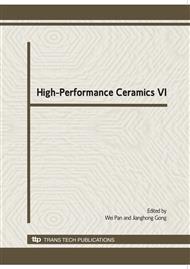p.514
p.518
p.522
p.526
p.530
p.534
p.538
p.542
p.546
Evaluating Absolute Hardness of Ceramic Coatings Using Relative Method
Abstract:
Micro-hardness measurements of thin coatings have to face the problem of the influence of the substrate. Based on relative method and the relationship between the composite hardness (the hardness of the coated sample) and the substrate hardness, a new model is proposed to evaluate the absolute hardness of ceramic coatings. Indentation tests with various load levels were carried out with specimens of (Ti,Al)xN1-x/SiyN1-y composite coating on SKH51 steel substrate. The results were analyzed by the new model and compared with those calculated by J-H (Jönsson and Hogmark) and L-C (Lesage and Chicot) models. The mean coating hardness obtained from this model shows similar results with the J-H model but a little higher than that from L-C model.
Info:
Periodical:
Pages:
530-533
Citation:
Online since:
March 2010
Authors:
Keywords:
Price:
Сopyright:
© 2010 Trans Tech Publications Ltd. All Rights Reserved
Share:
Citation:


